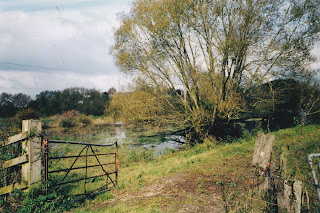Storms, electricity, epoxy and solar panels
We're into the winter storms here in the UK at the moment. There seems to have been nonstop wind and rain for weeks now. There are many people around the country who have suffered so much loss and damage from flooding and some amazing stories of compassion and rescue.
On a boat, weather determines so much about our lives that we become attuned to the moods of the sea and our lives are affected by it all the time. We have weather apps on shortcuts (Met office is our go-to on land, windguru and windfinder when we're on the water) watch the clouds carefully and frequently have conversations with neighbours about upcoming or passing storms or nice spells. Generally we know when another weather front is heading our way. But not always.
 |
| Image: Rain pouring down the windows |
Boxing day morning took everyone by surprise including the meteorologists and I was slightly late for work when the cross pontoon was moving too much to be safe to cross. There had been no predictions of winds and it came suddenly. Usually a drop in pressure will precede bad/unsettled weather and forecasting is now so good that the met office normally gives good warnings. I had been outside 20 minutes before and everything had been calm. This happened to us once before on our way from Carteret, Normandy to St Malo when the radio suddenly started giving out repeated méteo warnings. Even the announcer sounded worried as they gave out details of an unexpected increase in wind due to happen imminently and bringing 'agité' (rough) conditions. We were very relieved once we were safely locked in to the harbour basin.
 |
| Image: Wind charts from Boxing day showing sharp increase in wind speed |
It is not just the strength of the wind that is important in stormy conditions but also the direction. Winds are described by the direction that they come from. In South West Britain the prevailing (most common) direction for winds is south west to westerly which can give them a big run over the Atlantic before reaching us without land masses to slow them down. Once they reach us from that direction though, we are tucked behind a headland which protects us. The direction of the wind compared to the boat affects whether we are blown off (away from) the pontoon, constantly bounced into the pontoon or if the wind travels over the front or back of us. Being slammed into the solid pontoons is the one I find by far the most unpleasant and frightening. When we were at Topsham we would dry out each low tide on the mud. The wind would come up the river straight on the nose and when it was really bad it would feel like the boat would just flip end to end which at 12.5 tonnes would be quite a feat but was a terrifying thought. The other wind people tend to be aware of is Northerly's which can bring bitterly cold temperatures with them.
 |
| Image: Houses along river edge at Topsham towards Exmouth |
Despite the weather work is still progressing on the boat. We have been really pleased with the new settee cushions we had made for the saloon last year by a local company. The fabric is made for commercial premises like clubs and pubs which gives it a durability which has so far proved up to the job of family life on a boat. Rebuilding a supporting internal wall in one of the back cabins has created a space shaped specifically for a proper fridge, storage boxes and even a space for the ironing board complete with a block to stop it falling out when the boat moves.
 |
| Image: Cold beer and milk bottles in fridge door |
(the next section has been read, added to, edited and corrected for technical stuff by Mark)
Electricity has been a big thing with lots of planning and preparation reaching a point of visible progress. Mark has rebuilt an underfloor cockpit locker to hold the relocated battery bank, which was previously split between the two aft lockers. After much thought I (Mark) decided to upgrade the batteries to lithium, we now have half the nominal capacity (200Ah as opposed to 450Ah) but much more of that capacity is usable. We have solar panels and wind turbines in addition to shore power and Mark is fitting a shore charger/inverter and a MPPT solar controller so we have a more reliable on and off grid supply. With a new rotatory switch to enable us to turn the electricity supply off more easily this will make our lives easier in many ways and is a step towards improving the lighting and upgrading the heating. We've got a new solar panel which is connected by magic (or maybe just cable and the aforementioned controller - Mark) to the new batteries. As well as having lights running off the mains again rather than the small plug in lights we have been relying on this winter we are also able to have our better radio back. The bilge pumps which trigger automatically to remove water that collects in the bilge (under the floor boards) have also been out of action whilst the electrics were being sorted. With the amount of rain we have had, water was collecting and needed to be removed manually. We got a Draper water pump as a temporary measure to empty the bilges and will keep it as an addition to our manual emergency pump that helped save us several years ago.
 |
| Image: Flat lay - old switch panel and bus bar on template sheet |
 |
| Image: Open cupboard with control panels |
The cockpit is changing gradually with plans for replacing the doors, reshaping of the area above the gas locker to allow for the electrical controllers and a locker being built in a corner which will double as a table/shelf when we are able to sit out in the cockpit again. Some of you will know that it has been used as a tool storage area for a very long time now.
Next job is to batten down the hatches (not literally) for storm George that is coming our way from Spain and to remove the limpet that has taken up squatters rights in the small blue dinghy. The dinghy was rescued by us originally after it wedged itself between us and a pontoon in Hendaye and was never claimed (it was green and had obviously been underwater quite a long time). It was sunk again in the last storm and scraped several bits of sea life off of the pontoon. Every time we check, the limpet has moved - presumably looking for it's niche. There are complicated teenage plans afoot to try and get it back to it's old home at the weekend, could be interesting!
 |
| Image: Bow of small dinghy with water inside |
Stay safe in the storms.
 |
| Image: Cliffs, waves, blue sky & rainbow at Tintagel |





Comments
Post a Comment